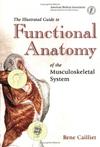骨骼肌肉系统功能解剖图谱The Illustrated Guide to Functional Anatomy of the Musculoskeletal System
2003-10
Amer Medical Assn
Cailliet, Rene
310
While clinicians today are trained in gross musculoskeletal anatomy, solid clinical evaluations demand a thorough knowledge of functional anatomy as well. The Illustrated Guide to Functional Anatomy of the Musculoskeletal System provides the groundwork you need to truly understand musculoskeletal function, the basis of all biomechanics. This outstanding guide will give you an important base knowledge of normal musculoskeletal function and how deviations are caused, helping you determine the most appropriate clinical diagnoses and treatments for your patients. Combining easy-to-read text with numerous quick-reference tables and clear illustrations, The Illustrated Guide to Functional Anatomy of the Musculoskeletal System logically covers both regional and systemic function. Chapters are organized by each segment of the musculoskeletal system for easy reference, presenting anatomical material that analyzes everyday activities and associated movements. Informative illustrations further deepen your knowledge of each musculoskeletal segment's function and how to clinically diagnose impairment. For years, clinical understanding of impaired function has been based on neuromuscular dysfunction with resultant pain. The Guide now helps you examine impaired neuromusculoskeletal activity more meaningfully by grounding it in functional anatomy. This is an outstanding primer for medical clinicians, medical students, residents, reimbursement coding staff, and other musculoskeletal allied health disciplines. Containing over 400 art pieces, this highly illustrated text is a primer for the medical clinician that logically blends regional and systemic coverage of anatomy for a complete overview of the subject. Features an easy-to-read narrative style combined with numerous illustrations that support the text. Functional and clinical information correlates with anatomical material that offers analyses of everyday activities and associated mov .
1 Concepts of Functional Anatomy Patterns Musculoskeletal Function Muscular Tone Muscle Contraction Effect of Tension on Muscular Contraction Characteristics of Muscle Contraction Collagen Articulations2 Functional Anatomy of the Lumbosacral Spin Structure and Function of the Spine Static Spine Lumbosacral Spine Kinetic Spine Posterior Spinal Elements Role of Muscles in the Activated Spine Lumbosacral Rhythm Ligaments in Spinal Function Spinal Instability Stability of the Static Spine Functional Anatomy of Discogenic Disease Neurological System of the Lumbar Spine3 Functional Anatomy of the Cervical Spine Upper Cervical Complex Ligaments of the Occipital-Atlas-Axis Segment of the Cervical Spine Lower Cervical Complex Uncovertebral Joint Kinetic Cervical Spine Function of the Uncinate Processes and Luschka Joints Innervation of the Upper Cervical Segment Musculature of the Cervical Spine4 Functional Anatomy of the Shoulder Scapulocostal Joint Muscles Acting on the Scapula The Glenohumeral Joint Rotator Cuff Kinetic Action of Muscles of the Glenohumeral Joint Kinetic Motion of the Glenohumeral Joint Scapulohumeral Rhythm Bicipital Mechanism of Glenohumeral Action Thoracic Outlet Functional Anatomy of Painful Syndromes5 Functional Anatomy of the Elbow, Wrist, Hand and Fingers The Elbow Extrinsic Muscles The Wrist Ligaments of the Wrist Carpal Bones Cubital Tunnel Navicular (Scaphoid) Bone The Hand and Fingers Metacarpal Bones Metacarpophalangeal Joint Phalanges Extrinsic Muscle-Tendinous Control6 Functional Anatomy of the Knee7 Functional Anatomy of Hip Joint8 Functional Anatomr of the Foot and AnkleIndex

骨骼肌肉系统功能解剖图谱The Illustrated Guide to Functional Anatomy of the Musculoskeletal System PDF格式下载